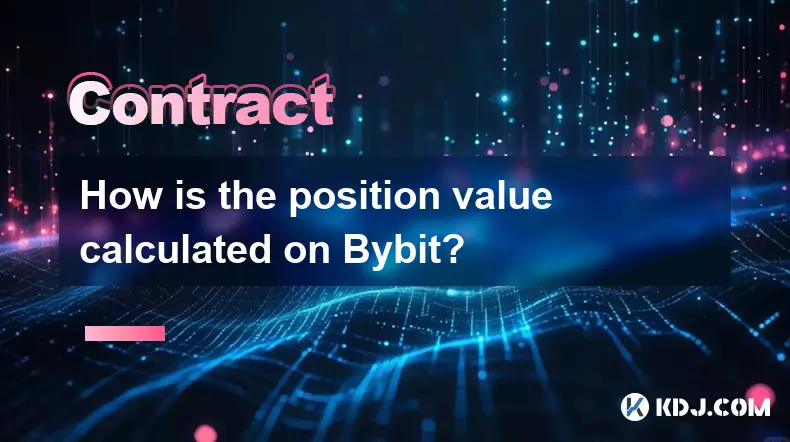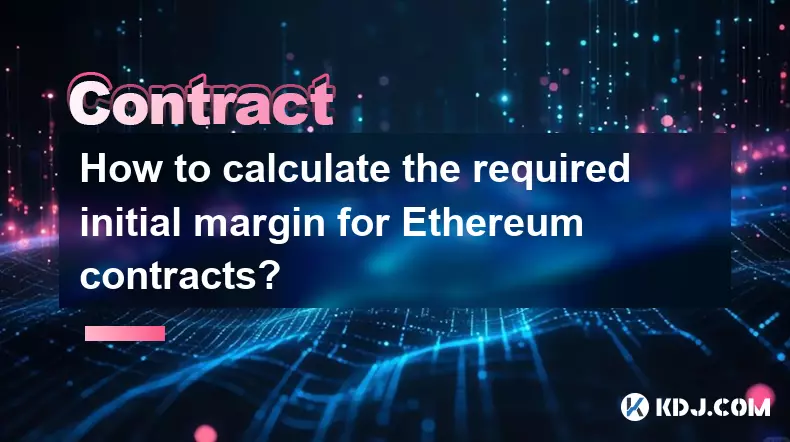-
 bitcoin
bitcoin $118548.520763 USD
3.67% -
 ethereum
ethereum $4352.564943 USD
4.79% -
 xrp
xrp $2.964058 USD
4.22% -
 tether
tether $1.000565 USD
0.05% -
 bnb
bnb $1028.372955 USD
1.46% -
 solana
solana $221.373507 USD
6.00% -
 usd-coin
usd-coin $0.999933 USD
0.02% -
 dogecoin
dogecoin $0.248633 USD
6.85% -
 tron
tron $0.341444 USD
2.38% -
 cardano
cardano $0.852946 USD
5.82% -
 hyperliquid
hyperliquid $47.869306 USD
6.15% -
 chainlink
chainlink $22.561476 USD
6.01% -
 ethena-usde
ethena-usde $1.001258 USD
0.05% -
 avalanche
avalanche $30.660000 USD
2.06% -
 stellar
stellar $0.400917 USD
9.76%
How is the position value calculated on Bybit?
Bybit calculates position value using mark price and position size, differing for inverse (in BTC) and linear (in USDT) contracts, impacting margin and liquidation risks.
Sep 22, 2025 at 05:00 pm

Understanding Position Value on Bybit
1. The position value on Bybit is determined based on the current market price of the asset and the size of the position held by the trader. It reflects the total worth of an open position in terms of the quote currency, such as USDT or USD. This calculation is essential for assessing margin requirements, liquidation levels, and profit or loss.
2. For inverse contracts, the position value is calculated in the base cryptocurrency. For example, in a BTC/USD contract, the value is expressed in BTC. The formula used is: Position Value = Position Size / Mark Price. This means that if you hold a long position of 10,000 USD worth of BTC/USD at a mark price of $50,000, your position value in BTC would be 0.2 BTC.
3. In linear contracts, which are settled in stablecoins like USDT, the position value is denominated directly in the quote currency. The formula applied here is: Position Value = Position Size × Mark Price. If a trader holds 1 BTC in a BTC/USDT linear contract and the mark price is $50,000, the position value equals $50,000.
4. The mark price is used instead of the last traded price to prevent manipulation and ensure fair valuation. It is derived from external spot prices and funding rates across multiple exchanges, providing a more accurate reflection of the true market value.
5. Traders must monitor their position value closely because it directly affects their margin ratio and risk of liquidation. A rising position value in a losing direction increases the likelihood of reaching the maintenance margin threshold, potentially triggering automatic closure of the position.
Impact of Leverage on Position Value
1. Leverage amplifies both gains and losses but does not alter the fundamental calculation of position value. However, it influences how much collateral is required to maintain the position. Higher leverage allows traders to control larger positions with less capital, thereby increasing exposure relative to equity.
2. When using high leverage, even small movements in the mark price can significantly affect the position’s value in relation to margin. For instance, a 2x increase in position value due to adverse price movement could quickly erode available margin under 100x leverage.
3. The effective cost basis and unrealized P&L are tied to the entry price and current mark price. As the position value changes, so does the floating profit or loss, which impacts the wallet balance and available funds for other trades.
4. Liquidation price calculations depend heavily on position value and leverage. Platforms like Bybit compute this by factoring in entry price, leverage, fees, and maintenance margin. An incorrect estimation of position value may lead to premature or unexpected liquidations.
5. Risk management tools such as stop-loss and take-profit orders rely on accurate position valuation. Misunderstanding how leverage interacts with position size and pricing can result in improper order placement and unintended outcomes.
Role of Contract Type in Valuation
1. Inverse perpetual contracts use the underlying asset (e.g., BTC) as the settlement currency. Therefore, position value is always calculated in the base coin. This introduces asymmetry between longs and shorts, especially during volatile swings, since the value fluctuates inversely with the USD price.
2. Linear perpetual contracts simplify valuation by expressing everything in stablecoin terms. Both long and short positions have symmetric payoff structures, making it easier for traders to interpret position value without converting between currencies.
3. Futures contracts, whether quarterly or delivery-based, follow similar principles but include time decay and funding mechanisms that indirectly influence perceived value over time. The settlement process also differs, affecting final realized value upon expiry.
p>4. Cross-margin mode spreads the available balance across all open positions, meaning the system evaluates position value collectively when determining margin health. Isolated margin, on the other hand, assigns dedicated funds per position, allowing for precise control over individual trade valuations.
5. Different contract types display position value differently on the trading interface. Users should verify which denomination—crypto or fiat—is being shown to avoid confusion when analyzing portfolio performance or setting risk parameters.
Frequently Asked Questions
How does funding rate affect position value?Funding rates do not directly change the position value but impact the periodic payments between longs and shorts. These transfers adjust the effective cost basis over time, influencing net profitability without altering the nominal value derived from mark price and size.
Why does my position value differ from entry value?Position value updates in real-time based on the mark price, while entry value remains fixed at the average fill price. Any divergence in market price after opening the trade will naturally cause a difference between these two figures.
Can position value go negative?No, position value cannot be negative. It represents the absolute market worth of the held contract. However, unrealized P&L can be negative, indicating a loss compared to the initial investment.
Is position value the same as wallet balance?Not necessarily. Wallet balance includes all assets, including available margin, realized profits, and unused funds. Position value refers only to the current market worth of active contracts, regardless of equity or liabilities.
Disclaimer:info@kdj.com
The information provided is not trading advice. kdj.com does not assume any responsibility for any investments made based on the information provided in this article. Cryptocurrencies are highly volatile and it is highly recommended that you invest with caution after thorough research!
If you believe that the content used on this website infringes your copyright, please contact us immediately (info@kdj.com) and we will delete it promptly.
- BlockDAG, DOGE, HYPE Sponsorship: Crypto Trends Shaping 2025
- 2025-10-01 00:25:13
- Deutsche Börse and Circle: A StableCoin Adoption Powerhouse in Europe
- 2025-10-01 00:25:13
- BlockDAG's Presale Buzz: Is It the Crypto to Watch in October 2025?
- 2025-10-01 00:30:13
- Bitcoin, Crypto, and IQ: When Genius Meets Digital Gold?
- 2025-10-01 00:30:13
- Stablecoins, American Innovation, and Wallet Tokens: The Next Frontier
- 2025-10-01 00:35:12
- NBU, Coins, and Crypto in Ukraine: A New Yorker's Take
- 2025-10-01 00:45:14
Related knowledge

What is the difference between futures and perpetual contracts for Bitcoin?
Oct 02,2025 at 11:54pm
Understanding Bitcoin Futures Contracts1. Bitcoin futures are derivative instruments that allow traders to speculate on the future price of Bitcoin at...

What is the maintenance margin for Bitcoin contracts?
Oct 02,2025 at 01:36am
Decentralized Exchanges Gain Momentum in 20241. Decentralized exchanges (DEXs) have seen a significant rise in trading volume, surpassing centralized ...

How to calculate the required initial margin for Ethereum contracts?
Oct 01,2025 at 06:01am
Understanding Initial Margin in Ethereum Futures1. The initial margin for Ethereum futures contracts represents the minimum amount of capital a trader...

What is a perpetual swap for Bitcoin contracts?
Oct 01,2025 at 08:18am
Understanding Perpetual Swaps in Bitcoin Trading1. A perpetual swap is a type of derivative contract that allows traders to speculate on the price of ...

What is the best platform for trading SOL contracts?
Oct 01,2025 at 06:36am
Understanding the Role of Decentralized Exchanges in Modern Crypto Trading1. Decentralized exchanges (DEXs) have reshaped how traders interact with di...

How to short sell Bitcoin using futures contracts?
Oct 01,2025 at 02:54am
Understanding the Role of Decentralized Exchanges in Crypto Trading1. Decentralized exchanges (DEXs) have become a cornerstone of the cryptocurrency e...

What is the difference between futures and perpetual contracts for Bitcoin?
Oct 02,2025 at 11:54pm
Understanding Bitcoin Futures Contracts1. Bitcoin futures are derivative instruments that allow traders to speculate on the future price of Bitcoin at...

What is the maintenance margin for Bitcoin contracts?
Oct 02,2025 at 01:36am
Decentralized Exchanges Gain Momentum in 20241. Decentralized exchanges (DEXs) have seen a significant rise in trading volume, surpassing centralized ...

How to calculate the required initial margin for Ethereum contracts?
Oct 01,2025 at 06:01am
Understanding Initial Margin in Ethereum Futures1. The initial margin for Ethereum futures contracts represents the minimum amount of capital a trader...

What is a perpetual swap for Bitcoin contracts?
Oct 01,2025 at 08:18am
Understanding Perpetual Swaps in Bitcoin Trading1. A perpetual swap is a type of derivative contract that allows traders to speculate on the price of ...

What is the best platform for trading SOL contracts?
Oct 01,2025 at 06:36am
Understanding the Role of Decentralized Exchanges in Modern Crypto Trading1. Decentralized exchanges (DEXs) have reshaped how traders interact with di...

How to short sell Bitcoin using futures contracts?
Oct 01,2025 at 02:54am
Understanding the Role of Decentralized Exchanges in Crypto Trading1. Decentralized exchanges (DEXs) have become a cornerstone of the cryptocurrency e...
See all articles










































































